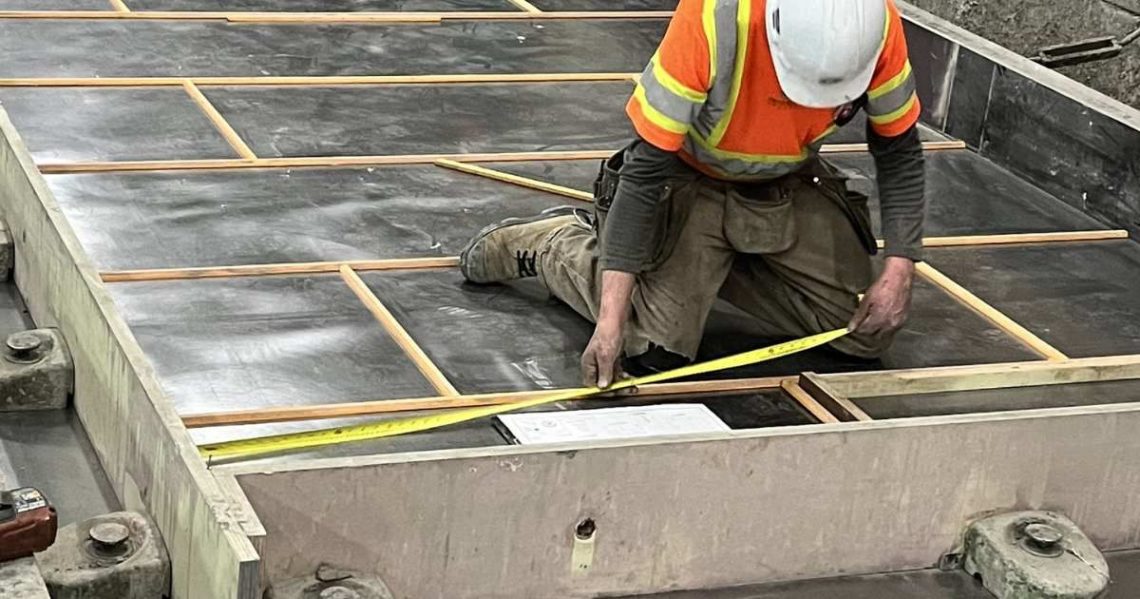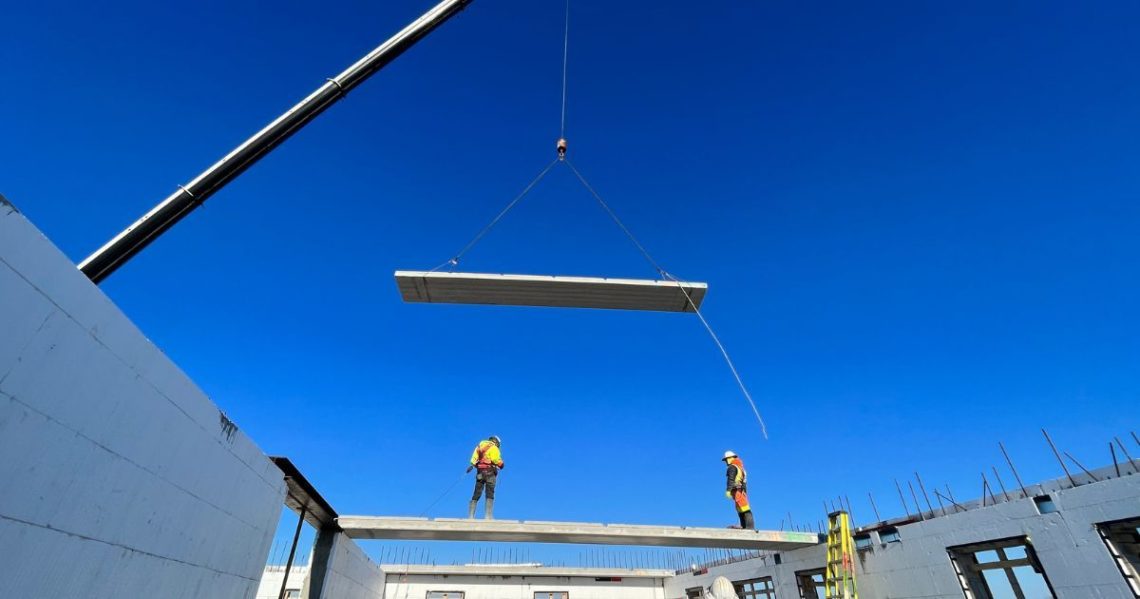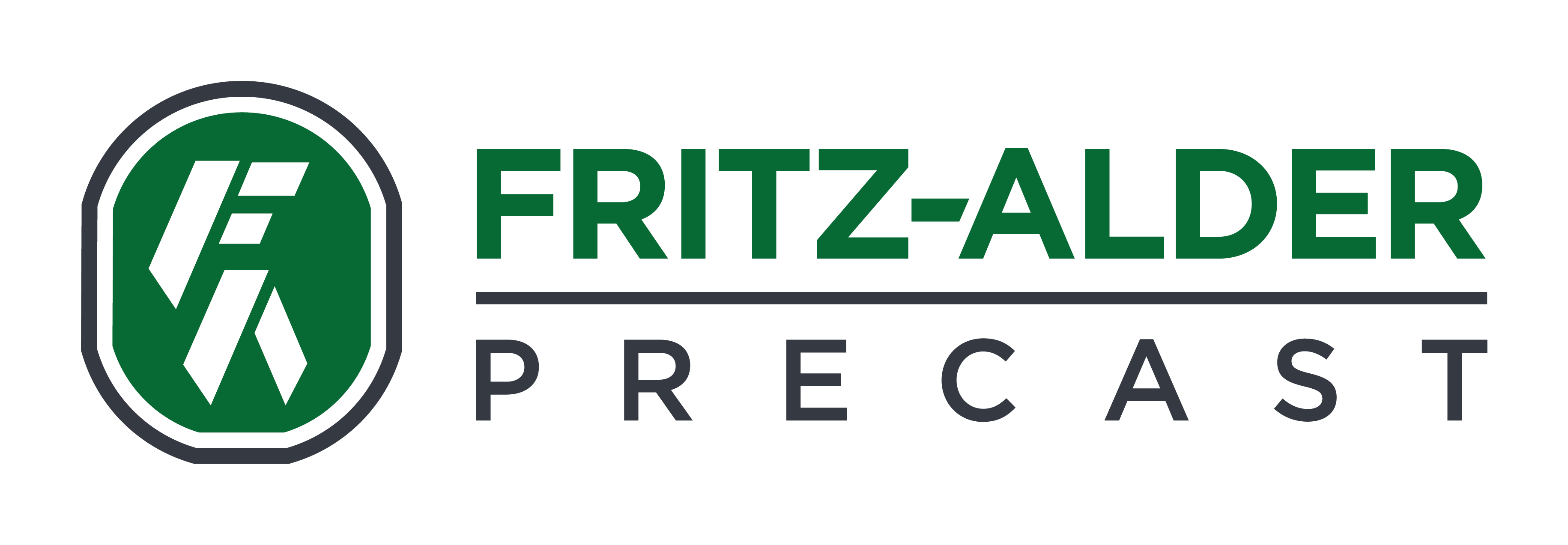Precast plants are hard to miss.
From the outside, it can look a bit like a concrete jungle. Ever wondered what happens behind the scenes?
If you’re curious about the inner workings of precast concrete, you’re in the right place. Let’s go on a bit of a behind-the-scenes tour and look at the process of precast concrete manufacturing—the gritty, demanding, and interesting process that turns raw materials into the precast products you see on site every day. Make sure you wear your steel-toed boots.
1. Precast Concrete Forms and Casting Beds
The foundation of precast manufacturing. Let’s start with how forms and casting beds shape concrete, the types of materials used, and how they’re prepared for casting.
Forms
Forms (or molds) are the starting point of most precast concrete products. They’re what provides the shape and ensures consistency across pieces.
Precast forms are most often made of steel, since it’s durable enough to be used hundreds or even thousands of times (and can be recycled Sustainability in Construction: How Sustainable Precast Concrete is Making a Difference once you’re done with it.) For one-off or custom shapes, wood forms may be used instead. A few other materials, like fiberglass and plastic, may be used for smaller pieces or to create detailed molds—but these are generally more the realm of decorative precast than walls and slabs.
Preparing molds for concrete is a multi-step process. A release agent is applied to the inside of the mold to prevent the concrete from sticking. Steel reinforcement bars (rebar) are placed within the mold to enhance the strength of the finished product. Other inserts, like lifting anchors or conduits for electrical wiring, may also be added ahead of time.
Casting Beds for Hollowcore Slabs
Hollowcore slabs, which are precision-engineered concrete slabs, are manufactured using casting beds rather than traditional molds. These slabs are specifically designed with hollow cores to reduce weight and material use.
A casting bed is essentially a long, flat surface on which the concrete is poured. Unlike enclosed molds, it’s open, which allows for continuous production and efficient extrusion of the concrete mix. This makes casting beds ideal for producing Hollowcore slabs at high volumes.
Before the concrete is poured, the casting bed is cleaned and lubricated, and steel strands are carefully positioned to reinforce the slab. The concrete is then deposited by a specialized machine that moves along the bed, depositing and leveling the concrete while simultaneously forming the hollow cores.
2. Concrete Batching: Precision and Quality Control
At the heart of precast concrete manufacturing is the concrete batching process—a carefully controlled operation where raw materials are measured and combined to create the perfect concrete mix.
Raw Materials
- Cement: The binding agent that holds the concrete together. It’s purchased in bulk and stored in silos to keep it dry and protected from the elements.
- Aggregates: Sand and stone provide the bulk and strength to the concrete. These are also purchased in bulk and kept in separate storage bins.
- Admixtures: These are chemicals added in small amounts to modify specific properties of the concrete, such as its workability, setting time, or resistance to freezing and thawing. Admixtures are usually stored in tanks or drums.
Weighing and Mixing
The batching process starts with precisely weighing each ingredient based on the specific mix design for the precast product being produced. This is done using electronic scales connected to a central control system that automates the process, ensures accuracy, and tracks inventory.
Once weighed, the ingredients are transferred to a mixer, which thoroughly blends them into a uniform mixture with the desired consistency.
Batch Quality Control
Throughout the batching process, rigorous quality control tests are performed to verify the properties of the concrete mix. These tests may include:
- Slump test: This measures the workability of the concrete, indicating how easily it flows and can be placed into forms or molds.
- Air content test: This determines the amount of air entrapped in the concrete, which is important for its freeze-thaw resistance.
- Temperature check: Concrete temperature is monitored to ensure it’s within the acceptable range for proper curing and strength development.
The results of these tests are used to fine-tune the mix if needed, guaranteeing that the concrete consistently meets the required specifications and performance standards.
3. Pouring and Placement
The carefully batched concrete mix is now ready to be transformed into precast. This stage usually happens within ten minutes of batching.
Pouring into Forms
Once the concrete mix is approved, it’s transported poured into the prepared forms or molds. The method of pouring varies depending on the specific product being produced and the size of the mold.
Concrete Consolidation
After the concrete is poured, it’s crucial to remove any trapped air bubbles that can weaken the final product. This is achieved through vibration, which consolidates the concrete and ensures it fills all corners of the mold and surrounds the reinforcement bars.
The intensity and duration of vibration must be carefully controlled to prevent over-vibration, which can lead to segregation of the concrete mix and compromise its strength.
Leveling and Smoothing
Once the concrete has been consolidated, the top surface is leveled and smoothed using a screed or trowel. This creates a uniform surface and prepares it for any additional finishing treatments, such as texturing or brushing, to achieve the desired appearance.

Extrusion in Casting Beds
We talked a bit about Hollowcore slabs earlier. For this product, the concrete is not poured into a mold but rather extruded onto a casting bed. A specialized extruder machine moves along the bed, depositing a continuous layer of concrete while simultaneously forming the hollow cores.
The top surface of the extruded slab is automatically leveled and smoothed by the extruder. Any additional finishing can then be done manually or with automated tools.
4. Curing
After the concrete has been poured and finished, it enters the curing phase—the step that allows the concrete to gain strength and harden over time.
During curing, a chemical reaction called hydration occurs, where the cement reacts with water to form a strong, durable matrix that binds the aggregates together.
Temperature Control
Curing is a temperature-sensitive process, and maintaining optimal temperatures is crucial for achieving the desired concrete properties.
Low temperatures can slow down the hydration process and delay strength development. Precast plants often use heating systems to keep the curing area warm during colder months.
High temperatures can cause the concrete to dry too quickly, leading to cracking and reduced strength. In warmer weather, cooling systems may be used to prevent excessive heat buildup.
Precast plants in regions with varying climates, like ours in Ontario, are careful to regulate the temperature in the plant throughout the year.
After the initial curing period, the precast products are typically moved to a designated curing area, where they continue to harden under controlled conditions for several days or weeks. The curing time and temperature are carefully monitored and adjusted based on the specific mix design and desired strength properties of the concrete.
5. Demolding, Handling, and Quality Assurance
Once the precast concrete has reached its specified strength, the next stage involves carefully separating them from the molds or casting beds. This is a careful process that requires skilled handling to avoid any damage to the finished product.
Demolding
For precast products cast in molds, the forms are gently removed. This is typically done by loosening the side panels or using hydraulic systems to carefully separate the mold from the concrete.
For continuous pieces like Hollowcore slabs, the process differs. The slab is first cut into individual sections using a specialized saw. These sections are then lifted off the casting bed.
Overhead cranes are the most common method for lifting and moving precast, especially larger ones. These cranes are equipped with hooks or specialized attachments to securely grip and transport the product.
Quality Assurance
Before being stored or transported, each precast product undergoes a thorough quality control process:
- Every piece is visually inspected for any imperfections, such as cracks, chips, or surface inconsistencies.
- Depending on the product and its intended use, additional tests might be conducted. This could include load testing to assess structural integrity or other specialized tests based on the project requirements.
Storage and Delivery
Precast plants usually have designated storage yards where finished products are organized and stored until delivery.
Deliveries are carefully coordinated with the construction site to ensure that the products arrive on time and in the correct order for installation.

The Human Element
While the machinery involved in precast concrete manufacturing is impressive and all, we’d be remiss not to mention the essential role played by skilled workers.
There’s a lot of physically demanding, hands-on work that goes into making concrete. Manufacturing precast concrete to a high-quality standard requires a solid understanding of the materials, engineering principles, and processes that we’ve barely scratched the surface of here.
From formulating the perfect concrete mix (both an art and a science), to reading technical drawings, to operating complex machinery, every step relies on the skill and experience of trained professionals.
At Fritz-Alder Precast, we take pride in our team’s well-rounded skills and experience. We have experts in mix design who understand the intricate science of concrete, while others specialize in rebar, formwork, and more. And our quality control inspectors carefully examine every precast element, and our operators are highly proficient at running the sophisticated machinery on our factory floor.
It’s this combination of technical know-how, experience, and commitment that allows us to consistently deliver high-quality precast products that meet and exceed industry standards.
Interested in learning how precast concrete can make a difference in your next project? Reach out to us for a detailed discussion and a personalized quote.
